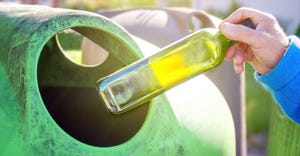Managing leachate at landfills can come at a great cost, especially in the face of tough regulatory demands that are only projected to get tougher. Throw in wastewater treatment plants imposing new pretreatment requirements on landfills and it presents an evolving challenge to landfill operators.
Entrepreneurs in the industry, however, are developing new methods aimed at cutting costs and increasing effectiveness upon traditional methods.
These issues will be explored during a session named “What’s New With Leachate Management” panel on Tuesday, May 9 at 2:00 PM at WasteExpo 2017.
Leachate Management Specialists, for example, has commercialized a new evaporation technology to dispose of leachate. Called WAIV (Wind Aided Intensified eVaporation). The method saves money and energy while reducing liability, says Brad Granley, president of Leachate Management Specialists, who will be one of the speakers at the session.
And it can be leveraged in multiple, site-specific scenarios.
The “evaporation structure” consists of a horizontal array of vertically mounted sails.
“We distribute leachate across the top of the sails. Gravity draws it down, and the capillary action of the hydrophilic material spreads it outward. Wind passing through the sails causes an intensified evaporation,” says Granley. The energy-conserving system functions with just a couple of pumps.
“So it aligns with our industry’s sustainability goals,” he says. “By using natural resources, it cuts operational cost by at least 50 percent. And you’re reducing both liability and greenhouse gas emissions by keeping leachate on site.”
WAIV works at landfills that receive municipal solid waste, construction and demolition waste and hazardous waste. It appears to hold up in climates from freezing zones to hot, human environments. And the system can be scaled, though currently is most applicable for sites managing one million to 10 million gallons of leachate per year.
Currently in operation in Australia and Mexico, the patented technology is coming to the U.S. with a WAIV installation under consideration in Florida. Leachate Management Specialists also has an approved project in Minnesota another potentially in the works in Missouri.
Meanwhile, engineering firm O’Brien & Gere has a customizable, web-based system that tracks operations of leachate treatment plants—from one dashboard. Its Process Control Monitoring system (PCM) allows landfill staff and corporate offices to access and share information and reports remotely, supporting them in running safely and in compliance.
PCM helps increase efficiency and cut costs, says Ken Jones, senior vice president of O’Brien & Gere. Jones will also present during the session at WasteExpo.
He cites as an example how Republic recently leveraged the firm’s technology.
“Republic wanted to track leachate treatment operating costs, per gallon, to compare facilities,” Jones says. “Typically there is no [tool to] look at all costs in one place to compare apples to apples, and this is what we did, calculating electricity, labor, chemicals and other expenses,” says Jones.
PCM facilitates a standardized process used, organization-wide, to provide information to drive efficiency, whether OSHA requirements and safety guidelines or system start-up instructions.
“It’s constantly evolving based on client feedback. Recently we built an operation and maintenance manual that’s easily navigated. For instance, if you need to assemble a pump, you go to a specific section and click on a link that takes you to the manufacturer for instructions,” says Jones.
The Rochem Group, a water treatment company, meanwhile, has a technology it says has been shown to yield zero liquid discharge from landfill.
The Rochem TS leachate treatment system leverages advanced osmosis to recover pure water from leachate and separate contaminants from high organic and mineral content. This pressure-driven process uses polymeric membranes to retain dissolved and suspended material, while allowing clean water to pass through the membrane.
The company has a client in Pennsylvania that is the first to go to zero discharge.
“This landfill has not discharged any treated or untreated leachate in the last two years and has been able to make water clean enough for almost all their onsite uses,” says Pat Stanford, Rochem’s vice president of engineering, who also be a presenter at the session.
The Rochem system’s primary benefits are landfills purchase little to no water, and the townships they serve do not have to expand their water capacity for site’s operational needs.
“These are the two biggest benefits. But in addition, since you don’t have to discharge you don’t need to use a National Pollutant Discharge Elimination System (NPDES) permit, so you avoid discharge fees. And you don’t have to buy nutrient credits [to offset carbon footprint],” says Stanford.
About the Author
You May Also Like




